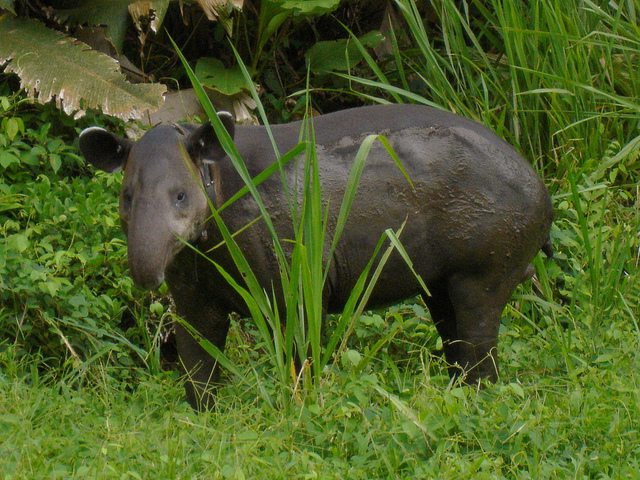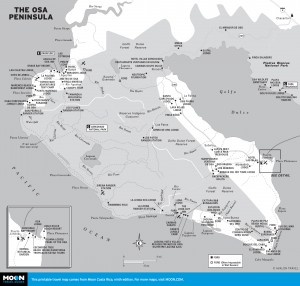
A tapir in Costa Rica’s Corcovado National Park. Photo © Miguel Vieira, licensed Creative Commons Attribution.

The Osa Peninsula
Parque Nacional Corcovado is the largest stronghold of Pacific coastline primary rainforest, which has been all but destroyed from Mexico to South America. Its 41,788 hectares (103,260 acres) encompass eight habitats, from mangrove swamp and jolillo palm grove to montane forest. The park protects more than 400 species of birds (20 exist only here), 116 species of amphibians and reptiles, and 139 of mammals—representing 10 percent of the mammals in the Americas in only a tiny fraction of the landmass.Its healthy population of scarlet macaws (about 1,200 birds) is the largest concentration in Central America. Corcovado is also a good place to spot the red-eyed tree frog and enamel-bright poison dart frogs. Corcovado is one of very few places in the country harboring squirrel monkeys, and one of the last stands in the world for the harpy eagle. Four species of sea turtles—green, olive ridley, hawksbill, and leatherback—nest on the park’s beaches. The park supports a healthy population of tapirs and big cats, which like to hang around the periphery of the Laguna de Corcovado. Corcovado also has a large population of peccaries. Alas, the park’s mammal population—notably peccaries—is under intense pressure from illegal hunting and logging.
The Osa Peninsula bears the brunt of torrential rains April-December. It receives up to 400 centimeters (157 inches) per year. The driest months, January-April, are the best times to visit.
Corcovado has a well-developed trail system, although the trails are primitive and poorly marked. Several short trails make for rewarding half- or full-day hikes. Longer trails grant an in-depth backpacking experience in the rainforest. Allow three days to hike from one end of the park to the other, which can be done in dry season only.
It’s 15 kilometers (9.5 miles) from the La Leona ranger station at Carate to Sirena, following the beach for most of the way. Allow up to eight hours. Beyond Punta Salsipuedes, the trail cuts inland through the rainforest. Don’t try this at high or rising tide: You must cross some rocky points that are cut off by high tide. Don’t trust the ranger’s statements—consult a tide table before you arrive. The hike from La Leona to the Madrigal waterfall is recommended.
A trail leads northeast to Los Patos via the Laguna de Corcovado. Another trail—only possible at low tide (not least because sharks like to come up the mouths of rivers in the hours immediately before and after high tide)—leads 23 kilometers (14 miles) to the San Pedrillo ranger station, at the northern boundary. There are three rivers to wade. The trick is to reach the Río Sirena and slightly shallower Río Llorona before the water is thigh-deep. Here, watch for crocodiles. Don’t let me put you off; dozens of hikers follow the trail each week. Halfway, the trail winds steeply into the rainforest and is often slippery. The last three kilometers (2 miles) are along the beach. The full-day hike takes you past La Llorona, a 30-meter (100-foot) waterfall that cascades spectacularly onto the beach. Tapirs are said to come down to the beach around sunrise, but you must remain silent at all times, as the animals are timid and easily scared away.
You can enter the park at San Pedrillo via the coast trail that leads south from Drake Bay, where lodges will also run you by boat. From the ranger station, a moderately demanding two-kilometer (1.2-mile) hike leads inland to a spectacular waterfall. Be careful; the rocks near its base are very slippery! It has pools beneath a cascade, good for bathing.
The trail south climbs steeply for six kilometers (4 miles) before flattening out for the final 14 kilometers (9 miles) to the Sirena Research Station. The trail is well marked but narrow, overgrown in parts, and has several river crossings where it is easy to lose the trail on the other side. You must wade. Be especially careful in rainy season, when you may find yourself hip-deep. There are three small shelters en route. A side trail will take you to the Laguna de Corcovado. Allow up to eight hours. Another trail leads from Los Patos to Los Planes.
A basic bunkhouse with foam mattresses (but no sleeping bags or linens) is available at Sirena ($8 pp), where there are showers and water; reservations are essential via the Corcovado park headquarters (in Puerto Jiménez, tel./fax 506/2735-5036, [email protected]). Rangers will cook meals by prior arrangement (breakfast $15, lunch and dinner $20), but you have to supply your own food.
Camping is allowed only at ranger stations ($4 pp). Rangers can radio ahead to the various stations within the park and book you in for dinner and a tent spot. No-see-ums, pesky microscopic flies you’ll not soon forget, infest the beaches and come out to find you at dusk. Take a watertight tent, a mosquito net, and plenty of insect repellent. You can rent tents and stoves in Puerto Jiménez from Escondido Trex.
Reservations are required for overnight stays, made through the park headquarters in Puerto Jiménez (tel./fax 506/2735-5036, [email protected]). Thirty days’ notice is recommended due to limited space; prepayment is required through Banco Nacional.
The park has four entry points: La Leona, on the southeast corner near Carate (the ranger station is about two kilometers/1.2 miles from Carate); Los Patos, on the northern perimeter; San Pedrillo, at the northwest corner, 18 kilometers (11 miles) south of Drake Bay; and Los Planes, on the northern border midway between San Pedrillo and Los Patos. You can also fly into the park headquarters at Sirena, midway between La Leona and San Pedrillo. All entry points are linked by trails. Entrance costs $10, prepaid at Banco Nacional, and the maximum stay is four nights.
You can charter Alfa Romeo Aero Taxi ($500, up to 5 people) to fly you to Sirena from Puerto Jiménez; otherwise you’ll have to hike in from Carate or one of the other access points. Boats from Marenco and Drake Bay will take you to either San Pedrillo or Sirena.
Excerpted from the Ninth Edition of Moon Costa Rica.